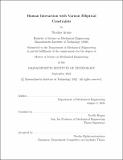Human Interaction with Various Elliptical Constraints
Author(s)
Arons, Nicolas
DownloadThesis PDF (716.4Kb)
Advisor
Hogan, Neville
Terms of use
Metadata
Show full item recordAbstract
Despite worse actuators and long feedback delays, humans outperform robots in a number of tasks, including tool use and physical interaction. In order to study the human controller, this work explores interaction with three different elliptical kinematic constraints. The shapes of these constraints were based on prior work: the circle was the same size as a previous crank-turning study; the aligned ellipse was based on estimates of the zero-force trajectory during circular crank-turning; the anti-aligned ellipse was a rotated version of the aligned ellipse. Subjects were given visual feedback on their velocity to decrease variability across trials, constraint shapes, and subjects. The velocity they were asked to track had a speed-curvature profile that was consistent with the two-thirds power law, which is widely reported in human motion.
Hypotheses about the experiment were made by modeling human physical interaction with a Norton equivalent network. The anti-aligned ellipse was hypothesized to evoke normal force and velocity error values higher than the circle, and the circle was hypothesized to evoke higher normal force and velocity error values than the aligned ellipse.
Statistical analysis revealed that the anti-aligned ellipse did evoke higher normal force and velocity errors than both the circle and aligned ellipse. There was no significant difference between the circle and aligned ellipse for either normal force or velocity error. The experiment was a success, however, in proving that constraint shape does affect the force that subjects exert on the constraint. This result suggests several further studies on human interaction with various kinematic constraints.
Date issued
2022-09Department
Massachusetts Institute of Technology. Department of Mechanical EngineeringPublisher
Massachusetts Institute of Technology